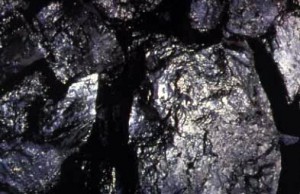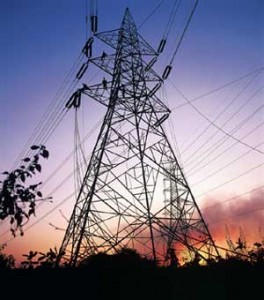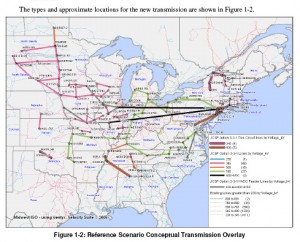ILSR’s Farrell on Fed Transmission Scam
June 29th, 2011
ILSR’s John Farrell is halfway there – he recognizes the federal part of the transmission equation, but the state part is missing, for example, Minnesota’s special eminent domain exemptions for “Public Service Corporations” (particularly where the transmission is for private profit, NOT public service), rate recovery for “Construction Work in Progress” and state regulators refusal to examine the interstate nature of transmission proposals. And the third part of that unholy trinity — in the Midwest, bulk power transmission would not be being built but for the Settlement Agreement – ME3(Fresh Energy), Izaak Walton League (and Walton’s program Wind on the Wires), Minnesota Center for Environmental Advocacy, and North American Water Office. This glut of transmission is their legacy. It takes all three to build transmission.
From Grist, today:
Feds running a high-voltage gravy train for power transmission
by John Farrell
28 Jun 2011 6:00 AM
Even as distributed generation shows economical and political advantages over centralized renewable energy, the Federal Energy Regulatory Commission (FERC) is running a high voltage gravy train in support of expanded transmission. FERC’s lavish program is expanding large transmission infrastructure at the expense of ratepayers instead of looking at more economical alternatives.Since 2007, FERC has had 45 requests for bonus incentives for transmission development — authorized under the 2005 Energy Policy Act — and has provided all or most of the requested incentives in more than 80 percent of the cases. With the bonuses, the average return on equity for utilities for their new transmission investments is nearly 13 percent. This high rate of return is a full 2.5 percentage points higher than the median utility return on equity [PDF], a value considered just and reasonable by state public service commissions in ordinary times. However, these rewards came during a time when unemployment doubled, the stock market tumbled, and most corporations were lucky to have any profit.The ratepayer impact of these bonuses is significant. In a November 2010 criticism of FERC transmission awards, Commissioner John Norris noted that the 2 percent bonus FERC provided to the PATH high-voltage project on the Eastern seaboard would “cost [Maryland] ratepayers in PJM at least $18 million per year.” The bonus payments were also given in concert with other incentives that reduced risk, including rate recovery during construction and guarantee of payment if the facilities were abandoned for reasons outside utility control.
LS Power’s Sunrise River plant voted DOWN!
February 17th, 2010
It’s nice to win sometimes, even in absentia…
Tonight the Chisago County Board of Commissioners, on a 3-2 vote, voted NOT to approve their proposed Development Agreement with LS Power for an 855MW (give or take a few hundred, depending on their mood, what they ate for lunch, whatever) natural gas electric generating plant. Like WOW!
Congratulations to Concerned River Valley Citizens for a job well done, and thanks to Tom Dunnwald who filled in for me tonight, but this is no time to let up — the work’s not over — there’s still the matter of the need for an Overlay Essential Services Ordinance that addresses generating plants and whatever other noxious infrastructure somebody might come up with.
This LS Power mess is the PROCEEDING that Concerned River Valley Citizens intervened in, under the Minnesota Environmental Rights Act, and were shut out by the County Attorney, Janet Reider (bad idea), and we just filed another Notice of Intervention yesterday or today.
There were some interesting comments, like “we’ve done the best we can in the time we had” indicating some sort of train schedule that has now been derailed. They tried to prevent attorneys from speaking, and the worst of that came from Commissioner Ben Montzka, who is an attorney himself! He should know better…
In the packet for tonight’s meeting:
It’s all on video, so we’ll have that soon. I can’t wait to see the snippets on YouTube!
Here’s from KARE 11:
(it’s not up yet)
More later
Transmission for coal – FERC AD05-3
March 21st, 2009
Yes, all this transmission we see, the hard to believe plans of superhighways across the country, MTEP, JCSP, Green Power Express, TrAIL line, Mid-Atlantic Power Pathway, Susquehanna-Roseland, on and on and on, it’s for coal, we know that, but when the truth jumps up and is as in-your-face as it is at this meeting… well, ya gotta read it to believe it. From the FERC docket entitled PROMOTING REGIONAL TRANSMISSION PLANNING AND EXPANSION TO FACILITATE FUEL DIVERSITY INCLUDING EXPANDED USES OF COAL-FIRED RESOURCES (really, that’s the name…):
Here, from p. 61, is a tantalizing snippet from the Pres. of PJM:
PJM is certainly proud of what has been accomplished to date to open up markets to coal, but there is much more that we and others in this region can do to further enhance that use of coal.
It is for this reason that, today, PJM is setting out by example, a new initiative which we have labeled Project Mountaineer — appropriately titled for the state that we’re in — to utilize our regional transmission expansion planning process to explore ways to further develop an efficient transmission super highway, if you will, to deliver the low-cost coal resources in this region of the country, to market.
And to actually build it when people don’t want it over their land, don’t want to look at it, don’t want the EMF impacts? Well, they say…
About the only answer to that would be some sort of federal siting law that would basically overcome local property rights.
National Interest Electric Transmission Corridors anyone? This was in 2005… as the CapX Technical Report was about to be published, putting all of this into action… sigh….
To look up the entire docket, go HERE and search for AD05-3, and voila, there it is for your edification and reading enjoyment!
It’s all for coal, we know that, and we’ve got to NOT let them get away with this!
MISO’s big transmission plans
March 9th, 2009
Another little birdie said that the MISO meeting to update everyone sitting in queue about their transmission plans was a bust… the good news, from my perspective, is that they don’t seem to be able to promise transmission for wind. Projects are added and drooled over, but there’s always problems and it’s not going anywhere, the same problems exist throughout:
At the meeting, they identified about 7 projects that might be able to make the transmission work from Group 6, one of which is Bent Tree I in Freeborn County. But there’s bad news — it will only require 7 new 345 lines to make these projects work, including a double-circuited 345kV line 345 double-circuit from Lakefield Jct. to Adams, extending the “Split Rock to Lakefield” as I expected since that 2002 SW MN 345kV project. Essentially, they’re doing #9 of the WRAO Report.
So, to recap, they’re talking 7 – 345kV lines, some 765kV lines, they’re talking a SECOND double circuit of the Brookings CapX 2020 line… building massive transmission TO THE EAST COAST!
AAAAAAAAAGH!
When will they understand what NYISO and ISO-NE understand — that there is renewable energy there too — where’s the market? And tranmission is no way to do this, there are better ways. Applies to the Chicago market too:
Michigan looks offshore for energy
By GEORGE WEEKS
Syndicated ColumnistMichigan was the Arsenal of Democracy in the mid-20th century. Gov. Jennifer Granholm strives to make it an arsenal of alternative energy in the early 21st century.
“She wants Michigan to be the leader in every sector of energy,” Stanley “Skip” Pruss, director of the Department of Energy, Labor and Economic Growth, said in a phone interview Friday.
Pruss, former deputy director of the Department of Environmental Quality and an assistant attorney general under Granholm and legendary Frank Kelley, said Michigan could be a “game changer” in wind energy.
He revealed that Wisconsin Gov. James Doyle seeks “a collaborative effort” on generating energy from offshore windmills in Lake Michigan.
Offshore wind has more punch than onshore wind. And the deeper the water, the more the punch, so near-shore is not as potent as far out.
Last week, an extensive examination of the offshore issue in the Traverse City Record-Eagle had this alert: “Nothing’s imminent, but state and environmental regulators are preparing for the possibility that utility developers may want to harness wind power from Lake Michigan and other big lakes.”
Subsequently, seriousness of such offshore preparations was underscored at assorted state forums, including the Michigan Wind Conference in Detroit, where Jennifer Alvarado, executive director of the Great Lakes Renewable Energy Association, sought to “showcase Michigan’s potential in being a major player when it comes to wind energy.”
Joint Coordinated System Plan
February 12th, 2009
With all these transmission proposals from hell announced, I think we’ve got to take a step backwards, and go through JCSP, the source of an insane “plan” for transmission across the U.S. JCSP is “Joint Coordinated System Plan,” which is MISO, PJM, SPP, TVA, and MAPP, getting together and fantacizing about transmission. This has nothing to do with need, with whether there’s a market, with whether it’s in the public interest, it’s what they want.
The NYT “Green Blog” had a post about this a couple of days ago that got this completely wrong, as you can see from the headline:
EARTH TO MARS — IT’S NOT FOR WIND.
Here’s a NYT “Green Blog” snippet with a look into the JCSP’smotivation (click for the whole thing):
The Joint Coordinated System Plan, as it is called, has been in development for months, according to the Midwest Independent System Operator, which is steering the project — and the full report will not be ready until the fall. But details of the plan were revealed on Monday in order to coincide with debate over the stimulus bill.
Yes, the stimulus bill. There’s a lot of money in that stimulus bill for transmission, and there’s NO money in the market for building transmission, or anything for that matter — remember, CapX 2020 was hustling Lehman Bros. for money, so it’s possible CapX won’t be built anytime soon. There they go to the government trough…
JCSP has it’s own site, just a contact form, with no contact information on it whatsoever, other than links to “the participants.”
Here’s their “plan” for transmission across the US:
So let’s see, we’ve got CapX 2020, MISO’s MTEP, the JCSP dream/nightmare plan, the Green Power Express… and they keep trying to couch their market dreams into wind, needed for RES. Can’t beople do a little background checking before they jump on this bandwagon? Can’t they do their due diligence like NYISO and ISO-NE?
DUH! There’s no market. This is such arrogance on the part of MISO…




